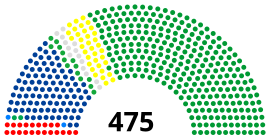National Diet
|
National Diet 国会 Kokkai |
|
|---|---|
| The 189th Ordinary Session | |
 |
|
| Type | |
| Type | |
| Houses |
House of Councillors House of Representatives |
| Leadership | |
| Structure | |
| Seats |
722 242 (House of Councillors) 475 (House of Representatives) |
 |
|
|
House of
Councillors political groups |
Government (146):
LDP (121)
Kōmeitō (25)
Oppositions (94):
DP (49)
JCP (14)
Initiatives (12)
PJK (3)
SDP (2)
PLP (2)
Energize (2)
Independents (12)
|
 |
|
|
House of
Representatives political groups |
Government (329):
LDP (294)
Kōmeitō (35)
Oppositions (146):
DP (96)
JCP (21)
Initiatives (15)
SDP/Shimin Rengō (2)
PLP(2)
Independents (10)
|
| Elections | |
|
House of
Councillors last election |
10 July 2016 (24th) |
|
House of
Representatives last election |
14 December 2014 (47th) |
| Meeting place | |
 |
|
| National Diet Building, Nagatachō, Chiyoda-ku, Tokyo | |
| Website | |
|
House of Councillors – official website House of Representatives – official website |
|
Government (146):
Oppositions (94):
Government (329):
Oppositions (146):
The National Diet (国会 Kokkai?) is Japan's bicameral legislature. It is composed of a lower house called the House of Representatives, and an upper house, called the House of Councillors. Both houses of the Diet are directly elected under parallel voting systems. In addition to passing laws, the Diet is formally responsible for selecting the Prime Minister. The Diet was first convened as the Imperial Diet in 1889 as a result of adopting the Meiji Constitution. The Diet took its current form in 1947 upon the adoption of the post-war constitution and is considered by the Constitution to be the highest organ of state power. The National Diet Building is located in Nagatachō, Chiyoda, Tokyo.
The houses of the Diet are both elected under parallel voting systems. This means that the seats to be filled in any given election are divided into two groups, each elected by a different method; the main difference between the houses is in the sizes of the two groups and how they are elected. Voters are also asked to cast two votes: one for an individual candidate in a constituency, and one for a party list. Any national of Japan at least 20 years of age may vote in these elections, which will be changed to 18 in 2016. Japan's parallel voting system is not to be confused with the Additional Member System used in many other nations.
...
Wikipedia
